GMC SIERRA 1996 Owners Manual
Manufacturer: GMC, Model Year: 1996, Model line: SIERRA, Model: GMC SIERRA 1996Pages: 404, PDF Size: 21.57 MB
Page 261 of 404
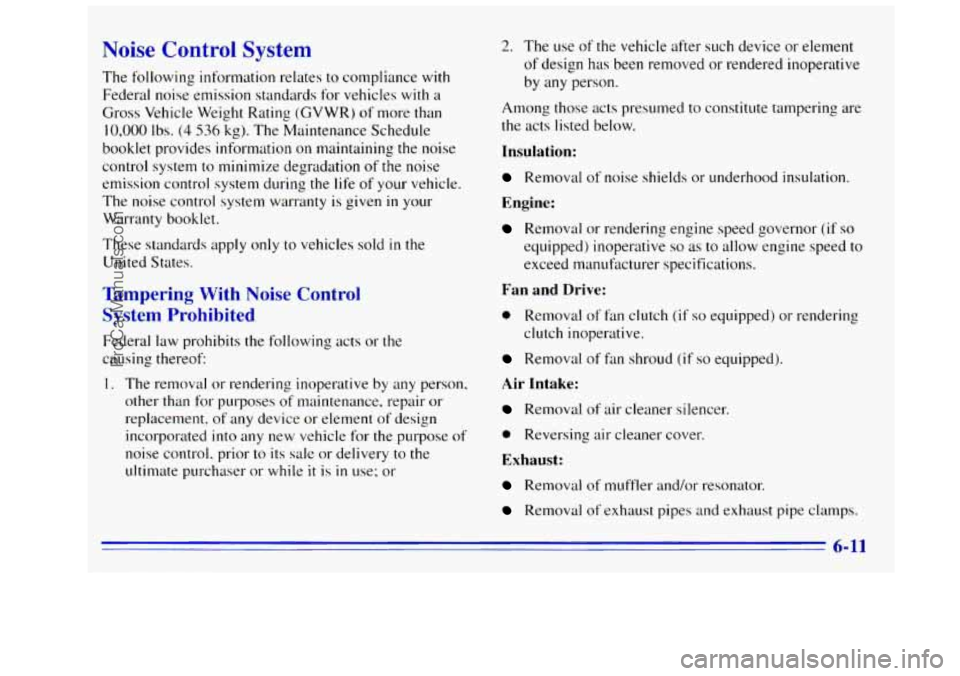
Noise Control System
The following information relates to compliance with
Federal noise emission standards for vehicles with
a
Gross Vehicle Weight Rating (GVWR) of more than
10,000 Ibs. (4 536 kg). The Maintenance Schedule
booklet provides information on maintaining
the noise
control system to minimize degradation
of the noise
emission control system during
the life of your vehicle.
The noise control system warranty is given
in your
Warranty booklet.
These standards apply only to vehicles
sold in the
United States.
Tampering With Noise Control
System Prohibited
Federal law prohibits the following acts or the
causing thereof:
1. The removal or rendering inoperative by any person,
other than for purposes of maintenance, repair or
replacement, of any device or element of design
incorporated into any new vehicle for the purpose
of
noise control. prior to its sale or delivery to the
ultimate purchaser or while
it is in use; or
2. The use of the vehicle after such device or element
of design has been removed or rendered inoperative
by any person.
Among those acts presumed
to constitute tampering are
the acts listed below.
Insulation:
Removal of noise shields or underhood insulation.
Engine:
Removal or rendering engine speed governor (if so
equipped) inoperative so as to allow engine speed to
exceed manufkcturer specifications.
Fan and Drive:
0 Removal of fan clutch (if so equipped) or rendering
clutch inoperative.
Removal of fan shroud (if so equipped).
Air Intake:
Removal of air cleaner silencer
@ Reversing air cleaner cover.
Exhaust:
Removal of muffler and/or resonator.
Removal of exhaust pipes and exhaust pipe clamps.
6-11
ProCarManuals.com
Page 262 of 404
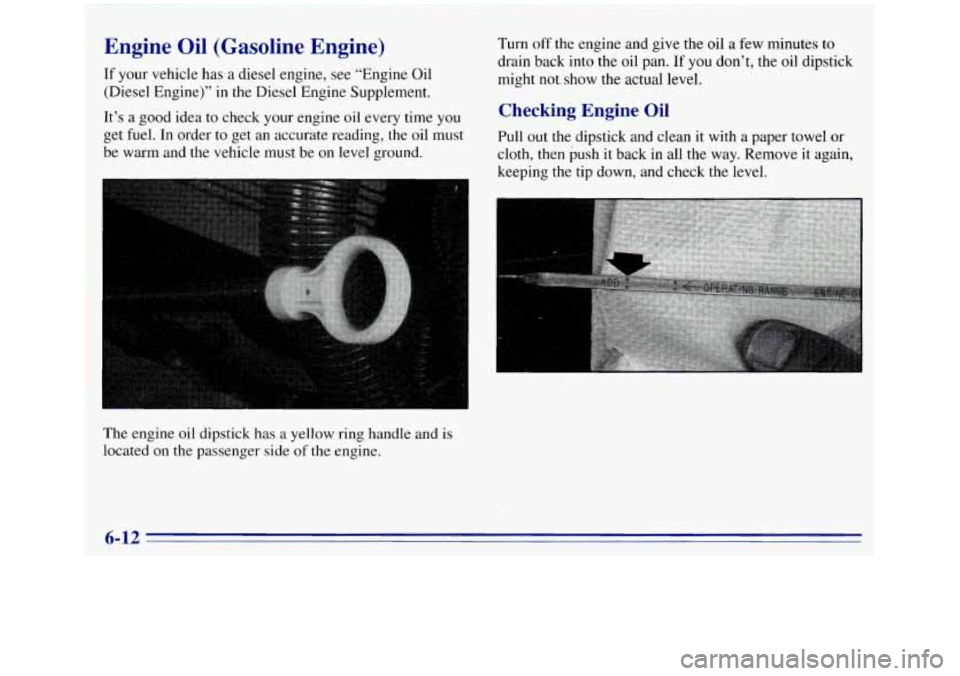
Engine Oil (Gasoline Engine)
If your vehicle has a diesel engine, see “Engine Oil
(Diesel Engine)” in the Diesel Engine Supplement.
It’s a good idea to check your engine oil every time you
get fuel. In order to get an accurate reading, the
oil must
be warm and the vehicle must
be on level ground. Turn
off the
engine and give the oil a few minutes to
drain back into the oil pan.
If you don’t, the oil dipstick
might not.show the actual level.
Checking Engine Oil
Pull out the dipstick and clean it with a paper towel or
cloth, then
push it back in all the way. Remove it again,
keeping the tip down, and check the level.
The engine oil dipstick has a yellow ring handle and is
located on the passenger side
of the engine.
6-12
ProCarManuals.com
Page 263 of 404
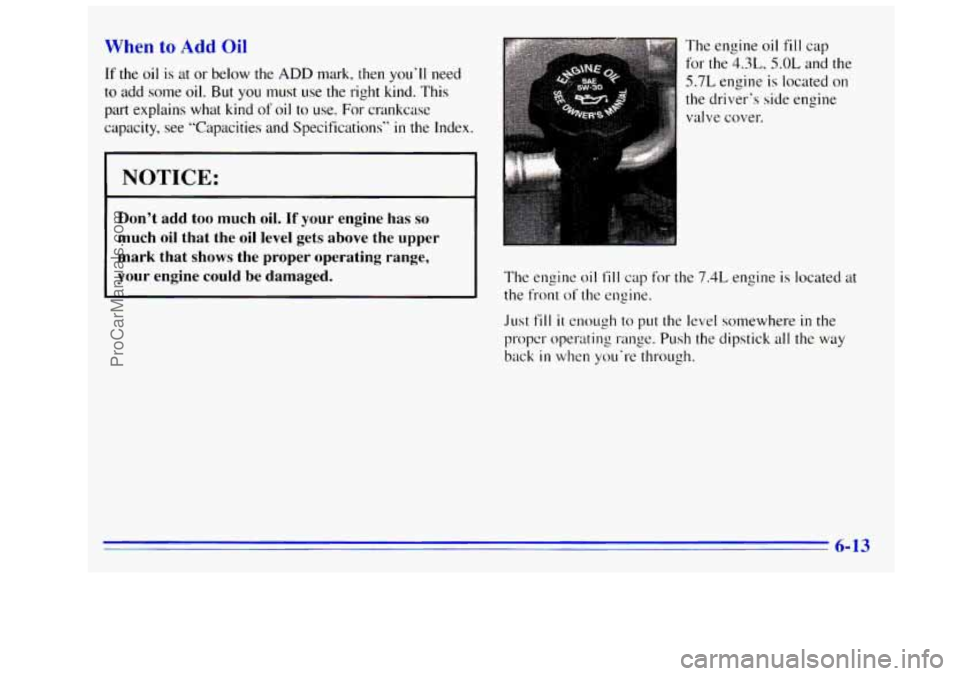
When to Add Oil
If the oil is at or below the ADD mark, then you'll need
to add some oil. But you must use the right kind. This
part explains what kind
of oil to use. For crankcase
capacity, see "Capacities and Specifications"
in the Index
NOTICE:
Don't add too much oil. If your engine has so
much oil that the oil level gets above the upper
mark that shows the proper operating range,
your engine could be damaged.
The engine oil fill cap
for the 4.3L, S.OL and the
S.7L engine is located on
the driver's side engine
valve cover.
The engine oil
fill cap for the 7.4L engine is located at
the front
of the engine.
Just fill it enough to put the level somewhere in the
proper operating range. Push the dipstick all the way
hack in when you're through.
6- 13
ProCarManuals.com
Page 264 of 404
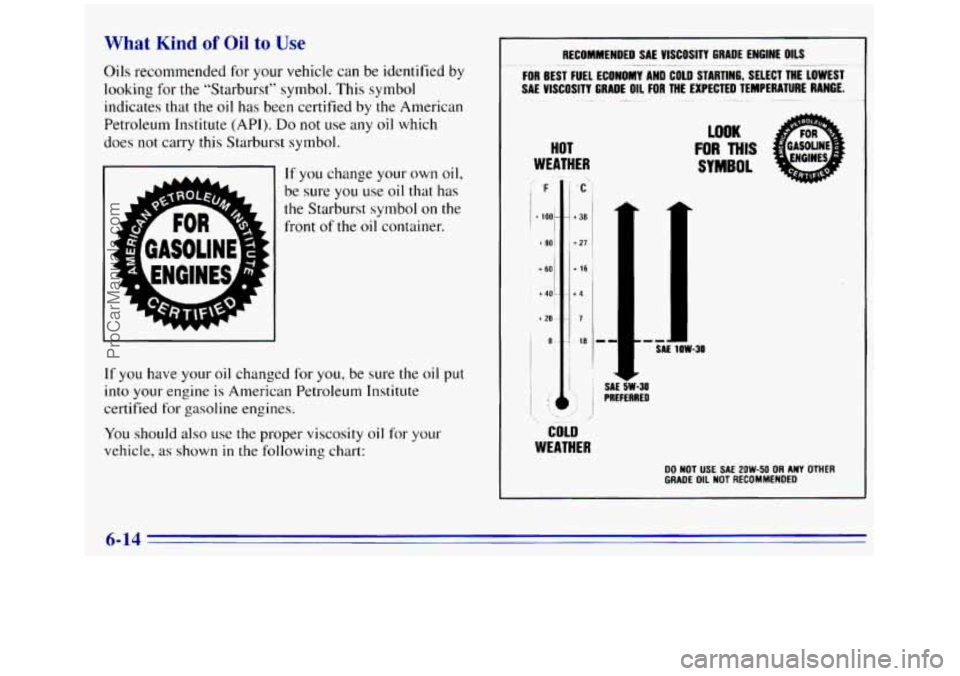
What Kind of Oil to Use
Oils recommended for your vehicle can be identified by
looking for the “Starburst” symbol. This symbol
indicates that the
oil has been certified by the American
Petroleum Institute
(API). Do not use any oil which
does not carry this Starburst symbol.
If you change your own oil,
be sure you use oil that has
the Starburst symbol on the
front of
the oil container.
If you have your oil changed for you, be sure the oil put
into your engine is American Petroleum Institute
certified for gasoline engines.
You should also use the proper viscosity oil for your
vehicle, as shown
in the following chart:
RECOMMENDED SAE VISCOSITY GRADE ENGINE OILS ~~ . . - . . -.
FOR BEST FUEL E Y AND COLD STARTING, SELECT THE LOWEST
~ ~~~ ~ ~
SAE VISCOSITY Gnnvr ulL FOR THE EXPECTED TEMPERATURE RANGE.
HOT
WEATHER
C
I +3*
+ 27
i SAE SW-30
’I PREFERRED
LOOK
FOR THIS
SYMBOL
COLD
WEATHER
DO NOT USE SAE 2OW-50 OR ANY OTHER GRADE OIL NOT RECOMMENDED
6-14
ProCarManuals.com
Page 265 of 404
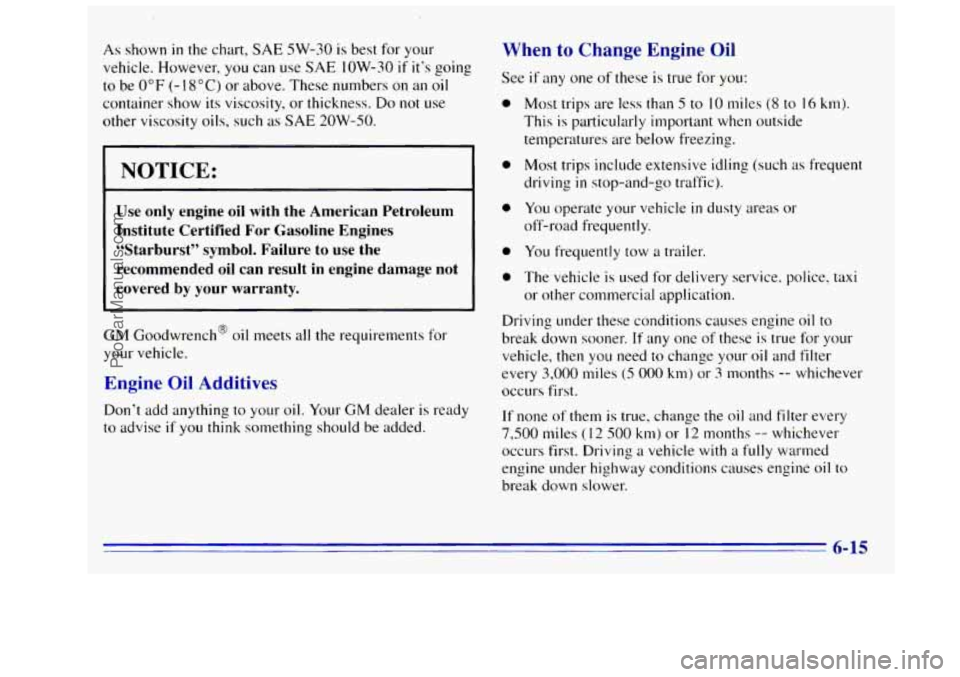
As shown in the chart, SAE 5W-30 is best for your
vehicle. However,
you can use SAE low-30 if it’s going
to be
0°F (-1 8°C) or above. These numbers on an oil
container show its viscosity, or thickness. Do not use
other viscosity oils, such as
SAE 20W-50.
I NOTICE:
Use only engine oil with the American Petroleum
Institute Certified For Gasoline Engines
“Starburst” symbol. Failure to use the
recommended oil can result in engine damage not
covered
by your warranty.
GM Goodwrench@ oil meets all the requirements for
your vehicle.
Engine Oil Additives
Don’t add anything to your oil. Your GM dealer is ready
to advise if you think something should be added.
When to Change Engine Oil
See if any one of these is true for you:
a
a
a
a
a
Most trips are less than 5 to 10 miles (8 to I6 km).
This is particularly important when outside
temperatures are below freezing.
Most trips include extensive idling (such as frequent
driving
in stop-and-go traffic).
You operate your vehicle in dusty areas or
off-road frequently.
You frequently
tow a trailer.
The vehicle is used for delivery service, police, taxi
or other commercial application.
Driving under these conditions causes engine oil to
break down sooner.
If any one of these is true for your
vehicle, then you need
to change your oil and filter
every
3,000 miles (5 000 km) or 3 months -- whichever
occurs first.
If none of them is true, change the oil and filter every
7,500 miles ( 12 500 km) or I2 months -- whichever
occurs first. Driving a vehicle
with a fully warmed
engine under highway conditions causes engine
oil to
break down slower.
6-15
ProCarManuals.com
Page 266 of 404
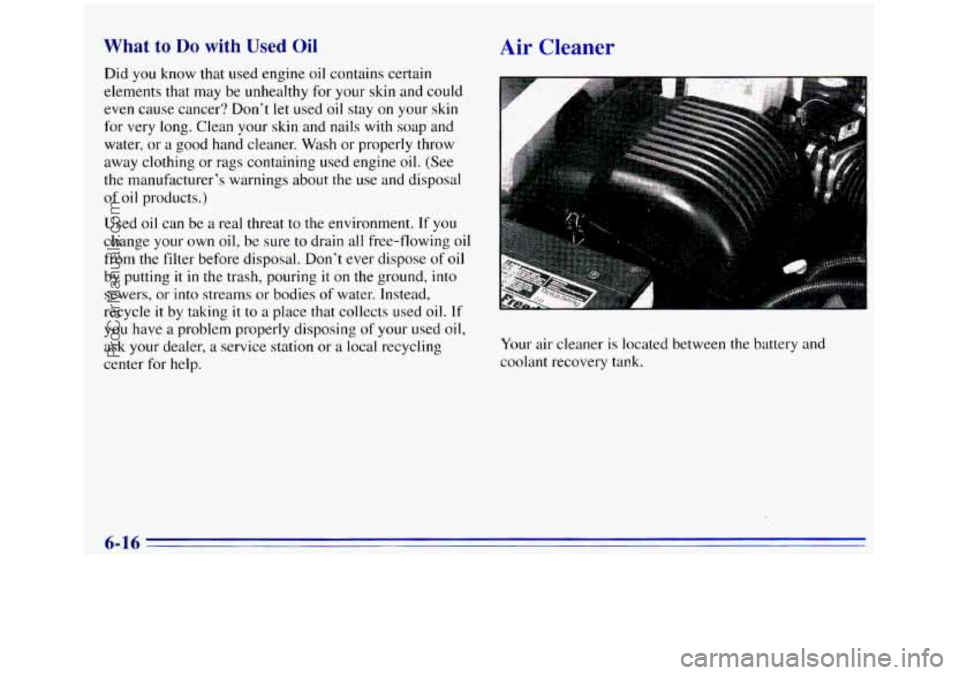
What to Do with Used Oil
Did you know that used engine oil contains certain
elements that
may be unhealthy for your skin and could
even cause cancer? Don’t let used
oil stay on your skin
for very long. Clean your skin and nails with soap and
water, or
a good hand cleaner. Wash or properly throw
away clothing or rags containing used engine oil. (See
the manufacturer’s warnings about the use and disposal
of oil products.)
Used
oil can be a real threat to the environment. If you
change your own
oil, be sure to drain all free-flowing oil
from the filter before disposal. Don’t ever dispose
of oil
by putting it in the trash, pouring it on the ground, into
sewers,
or into streams or bodies of water. Instead,
recycle
it by taking it to a place that collects used oil. If
you have a problem properly disposing of your used oil,
ask your dealer, a service station or a local recycling
center for
help.
Air Cleaner
Your air cleaner is located between the battery and
coolant recovery tank.
ProCarManuals.com
Page 267 of 404
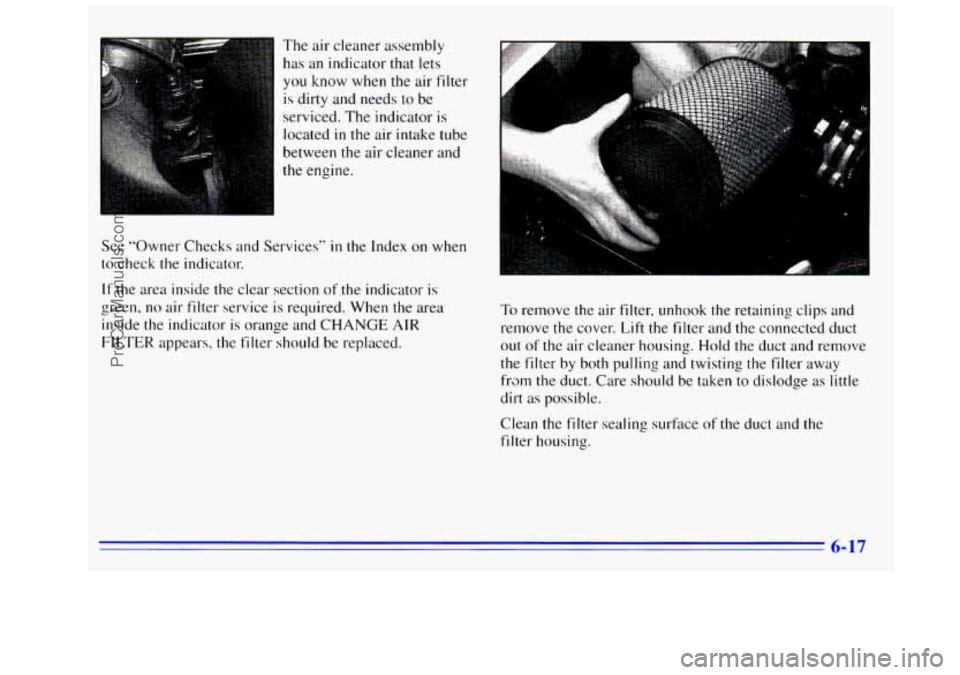
The air cleaner assembly
has an indicator that lets
you know when the air filter
is dirty and needs to be
serviced.
The indicator is
located
in the air intake tube
between the air cleaner and
the engine.
See “Owner Checks and Services”
in the Index on when
to check the indicator.
If the area inside the clear section of the indicator is
green, no air filter service is required. When the area
inside the indicator is orange and
CHANGE AIR
FILTER appears, the filter should be replaced.
To remove the air filter, unhook the retaining clips and
remove the cover. Lift the filter and the connected duct
out of the air cleaner housing. Hold the duct and remove
the filter by both pulling and twisting the
filter away
fram the duct. Care should be taken
to dislodge as little
dirt as possible.
Clean the filter sealing surface of the duct and the
filter housing.
6-17
ProCarManuals.com
Page 268 of 404
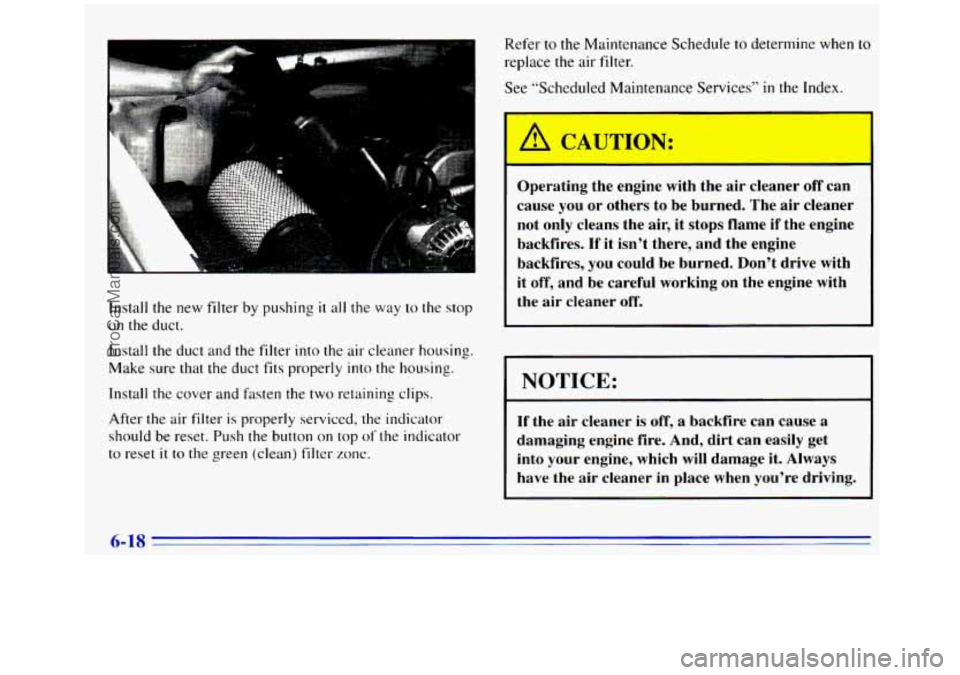
Install the new filter by pushing it all the way to the stop
on the duct.
Install
the duct and the filter into the air cleaner housing.
Make sure that the duct fits properly into the housing.
Install
the cover and fasten the two retaining clips.
After the air filter
is properly serviced, the indicator
should
be reset. Push the button on top of the indicator
to reset it to the green (clean) filter zone. Refer
to the
Maintenance Schedule to determine when to
replace the air filter.
See “Scheduled Maintenance Services”
in the Index.
I
Operating the engine with the air cleaner off can
cause you
or others to be burned. The air cleaner
not only cleans the air, it stops flame
if the engine
backfires.
If it isn’t there, and the engine
backfires,
you could be burned. Don’t drive with
it
off, and be careful working on the engine with
the
air cleaner off.
I NOTICE:
If the air cleaner is off, a backfire can cause a
damaging engine fire. And, dirt can easily get
into your engine, which
will damage it. Always
have the air cleaner
in place when you’re driving.
6-18
ProCarManuals.com
Page 269 of 404
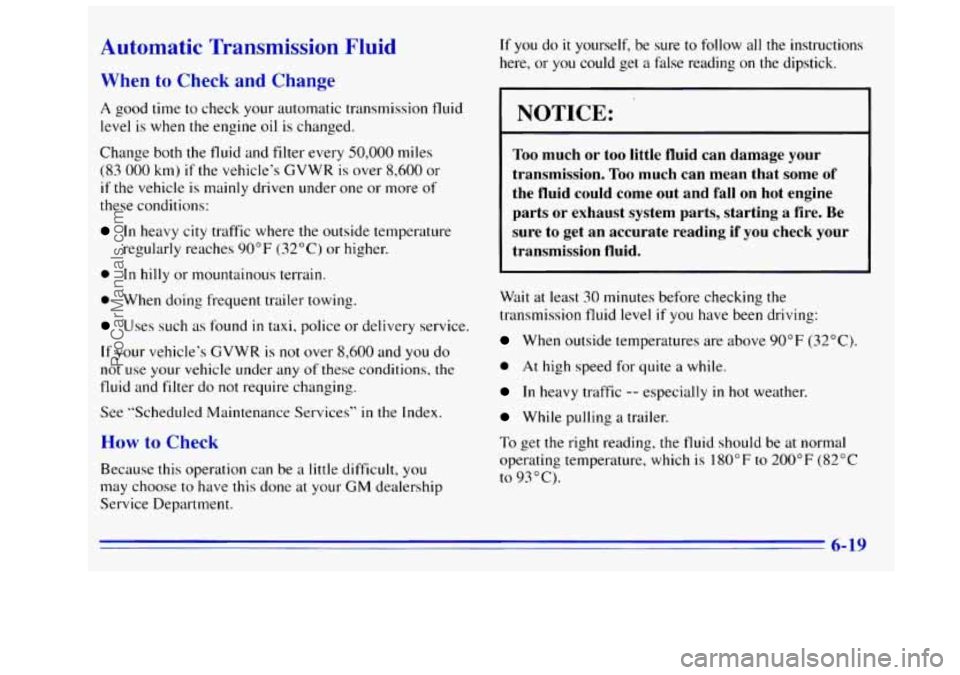
Automatic Transmission Fluid
When to Check a1 C’ -ge
A good time to check your auromarlc transmission fluid
level
is when the engine oil is changed.
Change both the fluid and filter every
50,000 miles
(83 000 km) if the vehicle’s GVWR is over 8,600 or
if the vehicle is mainly driven under one or more of
these conditions:
In heavy city traffic where the outside temperature
regularly reaches
90°F (32°C) or higher.
0 In hilly or mountainous terrain.
0 When doing frequent trailer towing.
Uses such as found in taxi, police or delivery service.
If your vehicle’s GVWR is not over 8,600 and you do
not use your vehicle under any of these conditions, the
fluid and filter
do not require changing.
See “Scheduled Maintenance Services’’
in the Index.
How to Check
Because this operation can be a little difficult, you
may choose to have this done at your GM dealership
Service Department. If
you do it yourself,
be sure to follow all the instructions
here, or
you could get a false reading on the dipstick.
NOTICE:
Too much or too little fluid can damage your
transmission.
Too much can mean that some of
i the fluid could come out and fall on hot engine
~ parts or exhaust system parts, starting a fire. Be
sure to get an accurate reading if you check your
transmission fluid.
Wait at least 30 minutes before checking the
transmission fluid level
if you have been driving:
When outside temperatures are above 90°F (32°C).
0 At high speed for quite a while.
In heavy traffic -- especially in hot weather.
While pulling a trailer.
To get the right reading, the fluid should be at normal
operating temperature, which
is 180°F to 200°F (82°C
to 93°C).
6-19
ProCarManuals.com
Page 270 of 404
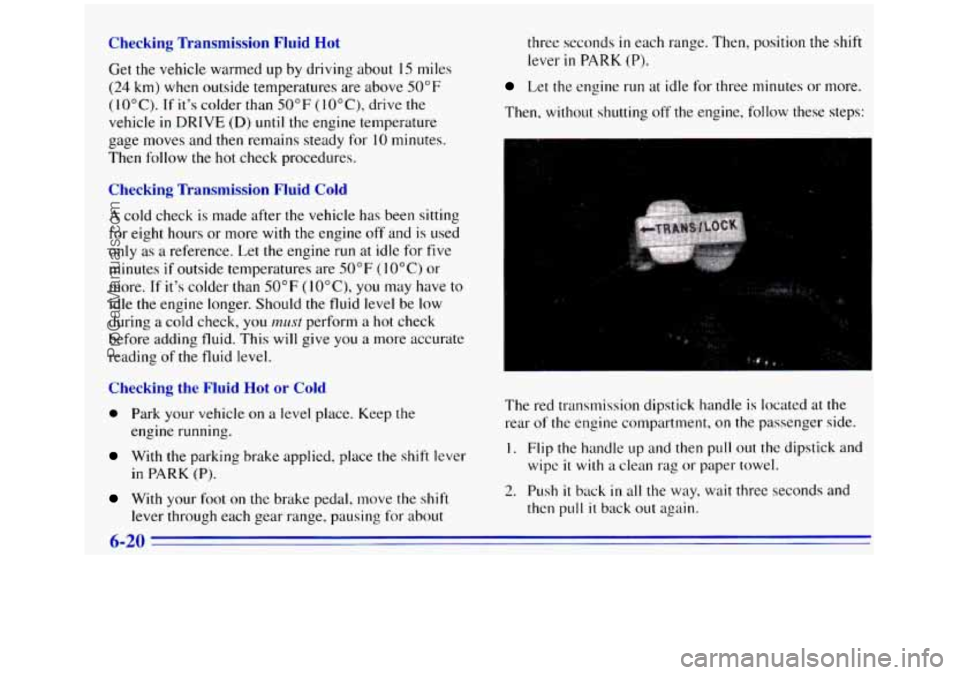
Checking Transmission Fluid Hot
Get the vehicle warmed up by driving about 15 miles
(24 km) when outside temperatures are above 50°F
(10°C). If it's colder than 50°F (lO"C), drive the
vehicle
in DRIVE (D) until the engine temperature
gage moves and then remains steady for
10 minutes.
Then
follow the hot check procedures.
Checking Transmission Fluid Cold
A cold check is made after the vehicle has been sitting
for eight hours or more with the engine off and is used
only
as a reference. Let the engine run at idle for five
minutes
if outside temperatures are 50°F (10°C) or
more. If it's colder than 50°F (lO"C), you may have to
idle the engine longer. Should
the fluid level be low
during a cold check, you nwst perform a hot check
before adding fluid. This will give you
a more accurate
reading
of the fluid level.
Checking the Fluid Hot or Cold
0 Park your vehicle on a level place. Keep the
engine running.
With the parking brake applied, place the shift lever
in PARK (P).
-,
With your foot on the brake pedal, move the shift
lever through each gear range, pausing for about three
seconds
in each range. Then, position the shift
lever
in PARK (P).
Let the engine run at idle for three minutes or more.
Then, without shutting off the engine, follow these steps:
The red transmission dipstick handle
is located at the
rear
of the engine compartment, on the passenger side.
I. Flip the handle up and then pull out the dipstick and
wipe
it with a clean rag or paper towel.
2. Push it back in all the way, wait three seconds and
then pull
it back out again.
6-20
ProCarManuals.com